President Trump wants to see China feel more pain
- President Trump has no intention of de-escalating trade war with China
- President Trump wants Chinese to suffer more from tariffs
- Deterioration in risk appetite among investors in early Asian trade on Monday.

US President Donald Trump has no intention of de-escalating trade tensions with China, according to Axios citing three unnamed sources with knowledge of his private conversations, believing instead that more time is required to make Chinese leaders to feel more pain from his tariffs.
According to Axios, one source told them that President Trump wants them to suffer more from tariffs, adopting the view that the longer his tariffs last, the more leverage he'll have in trade negotiations.
The US government has already introduced tariffs ranging from between 10% to 25% on $250 billion worth of Chinese goods entering the United States, triggering similar tariffs introduced by Chinese policymakers on US goods entering the nation, albeit on a smaller scale.
Another source told Axios that tit-for-tat trade war is only at the beginning of the beginning, suggesting there was unlikely to be a resolution despite the prospect of a meeting between Trump and Chinese dictator Xi Jinping on the sidelines of the G20 summit in Buenos Aires in November.
"It's a heads of state meeting, not a trade meeting," a source with direct knowledge told Axios.
"President Trump is thinking about this meeting as a personal reconnection with Xi, not a meeting that's going to evolve into detailed discussions," one source said.
"The sides are very far apart… right now, there's not the common basis for proceeding."
According to the report, President Trump is said to have taken a keen interest in the selloff in Chinese stocks this year — seeing the benchmark Shanghai Composite Index lose over 30% at one point from the highs struck in late January — boasting about the size of the decline seen since trade tensions between the two nations began to escalate.
According to the report, President Trump is said to have taken a keen interest in the selloff in Chinese stocks this year — seeing the benchmark Shanghai Composite Index lose over 30% at one point from the highs struck in late January — boasting about the size of the decline seen since trade tensions between the two nations began to escalate.
Sources said that President Trump believes this may pressure Chinese policymakers to return to the negotiating table.
"The generic point President Trump makes to aides, per a source with direct knowledge, is that 'we are strong and they are weak'," Axios said.
On Friday, Chinese policymakers announced a raft of new measures to help support stock prices, mirroring similar moves made in 2015 and 2016 to help halt an ugly plunge in stocks at the time.
Along with the recent slide in Chinese stocks, economic growth in China slowed to 6.5% in the year to September, according to latest figures from China's National Bureau of Statistics (NBS), the weakest result since the GFC.
"The key driver of this downturn was China's industrial sector, which grew at its slowest pace on record, amid the impact of deleveraging, the anti-pollution drive and trade tensions with the United States," said Gerard Burg, Senior International Economist at the National Australia Bank.
However, while the impact of the trade war may have contributed to the moderation in Chinese economic activity over the past year, Burg says China's trade surplus with the United States — rather than getting smaller — has actually increased to the highest level on record.
"The impact of US tariffs is yet to emerge in the outbound trade data with Chinese exports rising by 14% year-on-year," he says.
"In contrast, China's imports from the US fell by 1.2% year-on-year, potentially reflecting the impact of China's retaliatory tariffs.
"As a result, China's trade surplus with the United States has continued to expand, totalling $307 billion in the twelve months to September, a new record high."
The Axios report has been widely cited on social media platforms such as Twitter, and may be contributing to a slight weakening in investor risk appetite seen in early Monday morning trade in Asia.
Along with the recent slide in Chinese stocks, economic growth in China slowed to 6.5% in the year to September, according to latest figures from China's National Bureau of Statistics (NBS), the weakest result since the GFC.
"The key driver of this downturn was China's industrial sector, which grew at its slowest pace on record, amid the impact of deleveraging, the anti-pollution drive and trade tensions with the United States," said Gerard Burg, Senior International Economist at the National Australia Bank.
However, while the impact of the trade war may have contributed to the moderation in Chinese economic activity over the past year, Burg says China's trade surplus with the United States — rather than getting smaller — has actually increased to the highest level on record.
"The impact of US tariffs is yet to emerge in the outbound trade data with Chinese exports rising by 14% year-on-year," he says.
"In contrast, China's imports from the US fell by 1.2% year-on-year, potentially reflecting the impact of China's retaliatory tariffs.
"As a result, China's trade surplus with the United States has continued to expand, totalling $307 billion in the twelve months to September, a new record high."
The Axios report has been widely cited on social media platforms such as Twitter, and may be contributing to a slight weakening in investor risk appetite seen in early Monday morning trade in Asia.
Aucun commentaire:
Enregistrer un commentaire